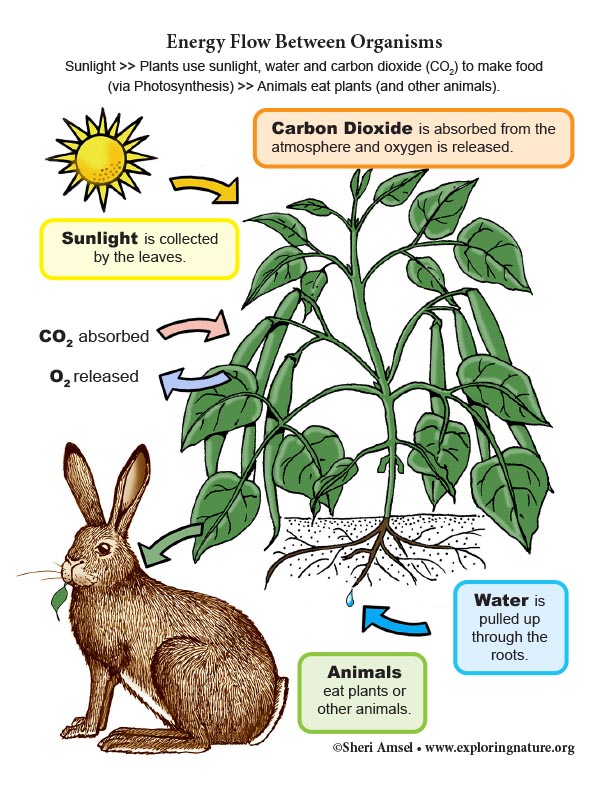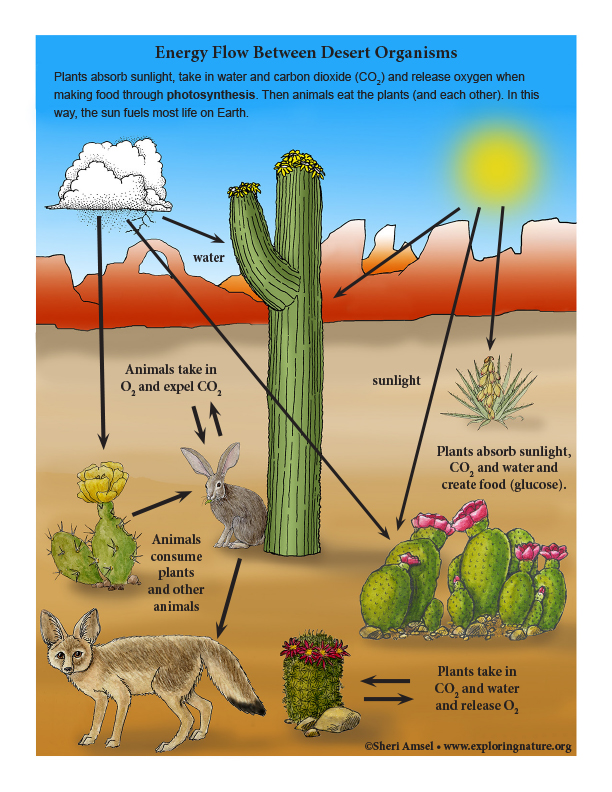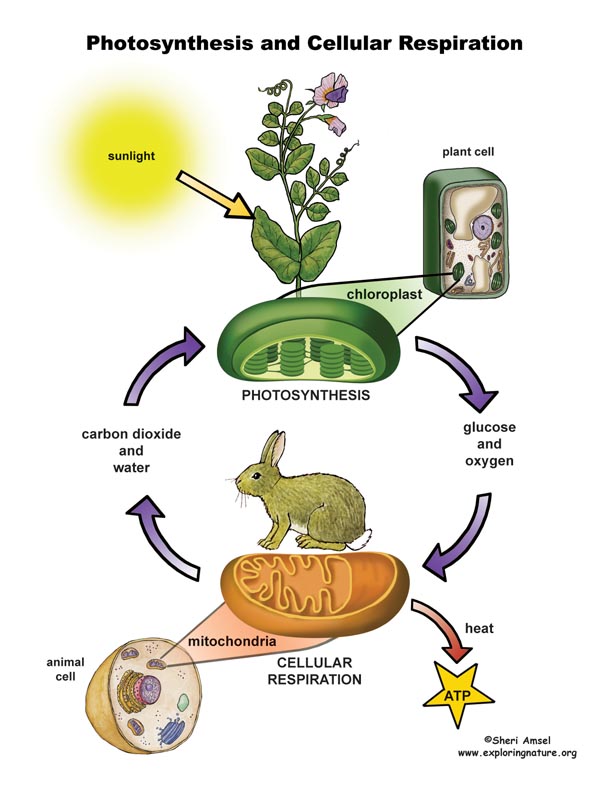

Disciplinary Core Ideas
LS1.C: Organization for Matter and Energy Flow in Organisms
• Plants, algae (including phytoplankton), and many microorganisms use the energy from light to make sugars (food) from carbon dioxide from the atmosphere and water through the process of photosynthesis, which also releases oxygen. These sugars can be used immediately or stored for growth or later use. (MS-LS1-6)
• Within individual organisms, food moves through a series of chemical reactions in which it is broken down and rearranged to form new molecules, to support growth, or to release energy. (MS-LS1-7)
PS3.D: Energy in Chemical Processes and Everyday Life
• The chemical reaction by which plants produce complex food molecules (sugars) requires an energy input (i.e., from sunlight) to occur. In this reaction, carbon dioxide and water combine to form carbon-based organic molecules and release oxygen. (secondary to MS-LS1-6)
• Cellular respiration in plants and animals involve chemical reactions with oxygen that release stored energy. In these processes, complex molecules containing carbon react with oxygen to produce carbon dioxide and other materials. (secondary to MS-LS1-7)
Use the Template and Resource Links to Fulfill NGSS
l. Goals:
NGSS Note: Think, question, entertain ideas.
ll. Introductory Activities to Assess Prior Knowledge about the Organization for Matter and Energy Flow in Organisms
A. Simple Activities - that assess students’ understanding of the chemical reactions of digestion of foods.
B. Simple Activities - that assess students’ understanding of photosynthesis and cellular respiration:
lll. New Knowledge about Organization for Matter and Energy Flow in Organisms
A. Read about energy flow between organisms and energy in chemocal processes and everyday life.
Energy Flow Between Organisms - Reading and Diagram
Energy in Chemical Processes and Everyday Life - Reading and Diagrams
B. Read about photosynthesis and cellular respiration.
Photosynthesis
Photosynthesis and Cellular Respiration
Cellular Respiration
A. Inquiry related to above topics:
Draw a cell, one organelle at a time and list their functions:
Drawing the Cells and Organelles
Explain what this comic means: Photosynthesis - Comic Relief Activity
What do plants need to grow? Photosynthesis - A Simple Experiment
What are the best conditions for plants to grow?
Photosynthesis Investigation
Photosynthesis in Action - Experiment
What Plants Need for Photosynthesis - Investigation
Energy Flow Between Desert Organisms - Model Building Activity
Energy in Chemical Processes and Everyday Life - Model Building
Photosynthesis and Cellular Respiration Diagram Labeling
Converting Energy in Everyday Life - Critical Thinking
Cycling of Matter in an Sealed Ecosystem - Explaining Phenomena
B. Authentic Performance - Understanding by Design (UbD) assessment tool.
Use critical thinking to complete thse Authentic Performance Activities and deepen your understanding about the above topics
Cellular Respiration - Authentic Performance Activity
Volcanic Apocalypse - Sunlight Authentic Performance
MS-LS1-6. Construct a scientific explanation based on evidence for the role of photosynthesis in the cycling of matter and flow of energy into and out of organisms. [Clarification Statement: Emphasis is on tracing movement of matter and flow of energy.] [Assessment Boundary: Assessment does not include the biochemical mechanisms of photosynthesis.]
MS-LS1-7. Develop a model to describe how food is rearranged through chemical reactions forming new molecules that support growth and/or release energy as this matter moves through an organism. [Clarification Statement: Emphasis is on describing that molecules are broken apart and put back together and that in this process, energy is released.] [Assessment Boundary: Assessment does not include details of the chemical reactions for photosynthesis or respiration.] MS-LS1-8. Gather and synthesize information that sensory receptors respond to stimuli by sending messages to the brain for immediate behavior or storage as memories. [Assessment Boundary: Assessment does not include mechanisms for the transmission of this information.]
Next Generation of Science Standards (NGSS) - Middle School Life Science
Disciplinary Core Ideas
LS1.C: Organization for Matter and Energy Flow in Organisms
• Plants, algae (including phytoplankton), and many microorganisms use the energy from light to make sugars (food) from carbon dioxide from the atmosphere and water through the process of photosynthesis, which also releases oxygen. These sugars can be used immediately or stored for growth or later use. (MS-LS1-6)
• Within individual organisms, food moves through a series of chemical reactions in which it is broken down and rearranged to form new molecules, to support growth, or to release energy. (MS-LS1-7)
PS3.D: Energy in Chemical Processes and Everyday Life
• The chemical reaction by which plants produce complex food molecules (sugars) requires an energy input (i.e., from sunlight) to occur. In this reaction, carbon dioxide and water combine to form carbon-based organic molecules and release oxygen. (secondary to MS-LS1-6)
• Cellular respiration in plants and animals involve chemical reactions with oxygen that release stored energy. In these processes, complex molecules containing carbon react with oxygen to produce carbon dioxide and other materials. (secondary to MS-LS1-7)
Science and Engineering Practices
Constructing Explanations and Designing Solutions
Constructing explanations and designing solutions in 6–8 builds on K–5 experiences and progresses to include constructing explanations and designing solutions supported by multiple sources of evidence consistent with scientific knowledge, principles, and theories.
• Construct a scientific explanation based on valid and reliable evidence obtained from sources (including the students’ own experiments) and the assumption that theories and laws that describe the natural world operate today as they did in the past and will continue to do so in the future. (MS-LS1-5),(MS-LS1-6)
Developing and Using Models
Modeling in 6–8 builds on K–5 experiences and progresses to developing, using, and revising models to describe, test, and predict more abstract phenomena and design systems.
• Develop and use a model to describe phenomena. (MS-LS1-2)
• Develop a model to describe unobservable mechanisms. (MS-LS1-7)
Crosscutting Concepts
Energy and Matter
• Matter is conserved because atoms are conserved in physical and chemical processes. (MS-LS1-7)
• Within a natural system, the transfer of energy drives the motion and/or cycling of matter. (MS-LS1-6)
Connections to Nature of Science
Science is a Human Endeavor
• Scientists and engineers are guided by habits of mind such as intellectual honesty, tolerance of ambiguity, skepticism, and openness to new ideas. (MS-LS1-3)
Performance Expectations - Students who demonstrate understanding can:
MS-LS1-6. Construct a scientific explanation based on evidence for the role of photosynthesis in the cycling of matter and flow of energy into and out of organisms. [Clarification Statement: Emphasis is on tracing movement of matter and flow of energy.] [Assessment Boundary: Assessment does not include the biochemical mechanisms of photosynthesis.]
MS-LS1-7. Develop a model to describe how food is rearranged through chemical reactions forming new molecules that support growth and/or release energy as this matter moves through an organism. [Clarification Statement: Emphasis is on describing that molecules are broken apart and put back together and that in this process, energy is released.] [Assessment Boundary: Assessment does not include details of the chemical reactions for photosynthesis or respiration.] MS-LS1-8. Gather and synthesize information that sensory receptors respond to stimuli by sending messages to the brain for immediate behavior or storage as memories. [Assessment Boundary: Assessment does not include mechanisms for the transmission of this information.]
Common Core State Standards Connections:
| ELA/Literacy - | |
| RST.6-8.1 | Cite specific textual evidence to support analysis of science and technical texts. (MS-LS1-6) |
|---|---|
| RST.6-8.2 | Determine the central ideas or conclusions of a text; provide an accurate summary of the text distinct from prior knowledge or opinions. (MS-LS1-6) |
| WHST.6-8.2 | Write informative/explanatory texts to examine a topic and convey ideas, concepts, and information through the selection, organization, and analysis of relevant content. (MS-LS1-6) |
| WHST.6-8.9 | Draw evidence from informational texts to support analysis, reflection, and research. (MS-LS1-6) |
| Mathematics - | |
| 6.EE.C.9 | Use variables to represent two quantities in a real-world problem that change in relationship to one another; write an equation to express one quantity, thought of as the dependent variable, in terms of the other quantity, thought of as the independent variable. Analyze the relationship between the dependent and independent variables using graphs and tables, and relate these to the equation. (MS-LS1-6) |
*provided by the NGSS website
When you research information you must cite the reference. Citing for websites is different from citing from books, magazines and periodicals. The style of citing shown here is from the MLA Style Citations (Modern Language Association).
When citing a WEBSITE the general format is as follows.
Author Last Name, First Name(s). "Title: Subtitle of Part of Web Page, if appropriate." Title: Subtitle: Section of Page if appropriate. Sponsoring/Publishing Agency, If Given. Additional significant descriptive information. Date of Electronic Publication or other Date, such as Last Updated. Day Month Year of access < URL >.
Amsel, Sheri. "LS1.C: Organization for Matter and Energy Flow in Organisms (MS-LS1 From Molecules to Organisms: Structures and Processes)" Exploring Nature Educational Resource ©2005-2024. December 13, 2024
< http://www.exploringnature.org/db/view/Grade-6-8-MS-LS1-From-Molecules-to-Organisms-Structures-and-Processes-LS1C-Organization-for-Matter-and-Energy-Flow-in-Organisms >







